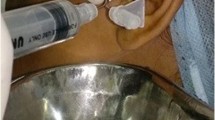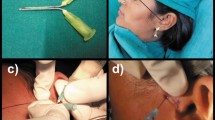Abstract
Introduction
Tempormandibular Joint (TMJ) Disorders require early diagnosis with a prompt and effective treatment. Arthrocentesis has been found to be a valuable treatment aid for patients with early stage internal derangement of temporomandibular joints. The use of this procedure has been well documented in literature and had been performed for decades. Arthrocentesis under local anaesthesia can be performed in two different techniques i.e Single puncture and Double puncture techniques.
Aims and Objectives
Our study was done to show the effectiveness of each of these techniques in aiding the patient as well as time taken to perform this procedure. Our study compares the two techniques to allow us to draw a proper conclusion on which can be put to use for better and less traumatic treatment of these patients.
Materials and Method
For this study 50 patients with Internal Derangement, group A was 25 patients that were treated with Arthrocentesis of 200 ml RL using OnePrick TMJ Arthrocentesis System with Single Puncture technique and group B consisted of 25 patients who were treated with Arthrocentesis of 200 ml RL using Double Puncture technique.
Result
We found a significant increase in maximal mouth opening in patients undergoing arthrocentesis regardless of the technique. Comparison of mean duration of surgery performed among different groups were assessed using sample T test. Mean duration of technique A is around 17.18 minutes whereas for technique B is 20.90 minutes. The mean difference for two techniques performed is –3.722 with P value of 0.001. In technique A 24% of subjects needed additional lavage whereas in techniques B it is 20 %. On an average, total of 22 % of subjects needed additional lavage for better results. The resultant p value is around 0.733.
Discussion
The traditional double puncture technique involves the insertion of two needles into the upper joint space. Difficulties in accurate triangulation, positioning of the needle, and frequent intraoperative needle dislocations lead to longer operating times and are often encountered with the double puncture technique. On comparing the two arthrocentesis techniques in terms of easiness to operator a study done showed the group treated with single needle techniques found it easier than the double needle technique. The difference between groups was significant. The mean difference for two techniques performed was seen to be above three minutes in our study which was statistically significant.
Conclusion
Single needle technique is advantageous in the fact that it takes a shorter duration to perform, is less invasive and easier for the operator to complete successfully.




Similar content being viewed by others
References
Nitzan DW, Dolwick MF, Martinez GA (1991) Temporomandibular joint arthrocentesis: a simplified treatment for severe, limited mouth opening. J Oral Maxillofac Surg 49(11):1163–1167
Şentürk MF, Yıldırım D, Bilgir E, Fındık Y, Baykul T (2018) Long-term evaluation of single-puncture temporomandibular joint arthrocentesis in patients with unilateral temporomandibular disorders. Int J Oral Maxillofac Surg 47(1):98–102
Guarda-Nardini L, Manfredini D, Ferronato G (2008) Arthrocentesis of the temporomandibular joint: a proposal for a single-needle technique. Oral Surg Oral Med Oral Pathol Oral Radiol Endodontol 106(4):483–486
Nagori SA, Jose A, Roychoudhury A (2020) Comparison of intraoperative outcomes with single and double puncture techniques of arthrocentesis of the temporomandibular joint. Br J Oral Maxillofac Surg 58(8):928–932
Şentürk MF, Cambazoğlu M (2015) A new classification for temporomandibular joint arthrocentesis techniques. Int J Oral Maxillofac Surg 44(3):417–418
Şentürk MF, Yazıcı T, Fındık Y, Baykul T (2018) Intraoperative comparison of single-and double-puncture techniques in temporomandibular joint arthrocentesis. Int J Oral Maxillofac Surg 47(8):1060–1064
Wilkes CH (1989) Internal derangements of the temporomandibular joint. Pathological variations. Arch Otolaryngol Head Neck Surg 115(4):469–477
Soni A (2019) Arthrocentesis of temporomandibular joint-bridging the gap between non-surgical and surgical treatment. Ann Maxillofac Surg 9(1):158
Alkan A, Baş B (2007) The use of double-needle canula method for temporomandibular joint arthrocentesis: clinical report. Eur J Dent 1(03):179–182
Bayramoğlu Z, Tozoğlu S (2021) Comparison of single-and double-puncture arthrocentesis for the treatment of temporomandibular joint disorders: a six-month, prospective study. CRANIO® 39(2):151–156
Folle FS, Poluha RL, Setogutti ET, Grossmann E (2018) Double puncture versus single puncture arthrocentesis for the management of unilateral temporomandibular joint disc displacement without reduction: a randomized controlled trial. J Cranio-Maxillofac Surg 46(12):2003–2007
Guarda-Nardini L, Ferronato G, Manfredini D (2012) Two-needle versus single-needle technique for TMJ arthrocentesis plus hyaluronic acid injections: a comparative trial over a six-month follow up. Int J Oral Maxillofac Surg 41(4):506–513
Talaat W, Ghoneim MM, Elsholkamy M (2016) Single-needle arthrocentesis (Shepard cannula) vs. double-needle arthrocentesis for treating disc displacement without reduction. CRANIO® 34(5):296–302
Author information
Authors and Affiliations
Corresponding author
Additional information
Publisher's Note
Springer Nature remains neutral with regard to jurisdictional claims in published maps and institutional affiliations.
Rights and permissions
Springer Nature or its licensor (e.g. a society or other partner) holds exclusive rights to this article under a publishing agreement with the author(s) or other rightsholder(s); author self-archiving of the accepted manuscript version of this article is solely governed by the terms of such publishing agreement and applicable law.
About this article
Cite this article
Navaneetham, R., Navaneetham, A., Nagaraj, V. et al. Single-Puncture Versus Double-Puncture Technique Arthrocentesis in the Treatment of Internal Derangement of TM Joint—A Comparative Clinical Study. J. Maxillofac. Oral Surg. 22, 1060–1065 (2023). https://doi.org/10.1007/s12663-023-01986-5
Received:
Accepted:
Published:
Issue Date:
DOI: https://doi.org/10.1007/s12663-023-01986-5




